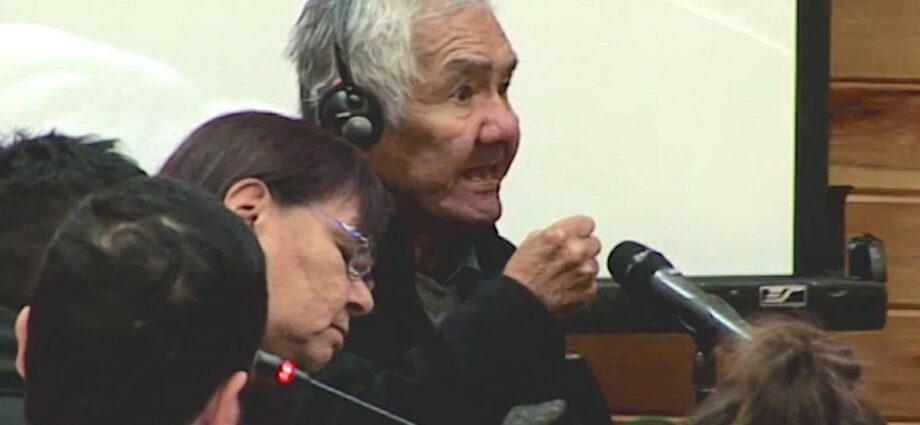
By Peter Jackson, Local Journalism Initiative Reporter, The Telegram
February 18, 2023
Legend has it that there was a great flood and all the animals ended up on a boat.
This isn’t the biblical legend of Noah’s ark, however.
It was the legend Annie Picard was told as a child by her Innu grandparents while they were out on the land.
The creation legend tells of various animals trying unsuccessfully to dive from their canoe to bring up a clump of land from the bottom. The muskrat finally succeeds, but drowns in the process.
With the help of a life-giving spirit, the earth begins to grow and is soon placed on the back of a large turtle, where it became what is now known as North America.
Variations of this tale persist in other First Nations cultures, and is the source of the Indigenous name “Turtle Island” to describe the continent.

Sheshatshiu story
Picard, health co-ordinator with the Innu Round Table (IRT) Secretariat, provided the bulk of testimony in Sheshatshiu Tuesday, Feb. 14, during the second day of the Inquiry into the Treatment, Experiences and Outcomes of Innu in the Child Protection System.
Picard was tasked with providing a detailed timeline of the Sheshatshiu First Nations people, which she did with the aid of a large, illustrated sheet of paper draped on the wall behind her.
She drew the pictorial cues herself as she gathered the stories from elders. They covered the very beginnings of life as a nomadic tribe, to the first significant contact with outside cultures around 1930, through the low-level flying protests of the 1990s and, of course, the legacy of children being swept out of broken communities and into non-Innu foster homes and facilities.
Self-determination
Picard, with the help of Germaine Benuan, finished her presentation with an overview of the Innu Nation’s push for control over its own child-protection services.
In 2020, it successfully launched a human rights complaint against the federal government because it was not receiving the same funding as other First Nations groups across Canada.
“We got the funding because we fought for it. The Innu, that’s how they got what we need, is fight for it,” she said.
![Sony PlayStation Store 110 - Sony, [Digital]](https://i0.wp.com/i5.walmartimages.com/asr/5d3e8d52-3525-4e75-b862-10394c67a31c.c3f21de9f6a2f65537248191772f43b3.png?w=1380&ssl=1)
Picard said the IRT and the province’s Department of Child, Youth and Family Services have been working collaboratively toward transferring control of child protection to Innu hands, although she says it will take a few more years to achieve.
“We have to design it for Innu children, and Innu people have to lead this project,” she said.
Moving testimony
Late Tuesday afternoon, the inquiry heard emotional testimony from Penote Antuan, a Sheshatshiu man who was sent to Mount Cashel Orphanage in St. John’s when he was about five years old.
A soft-spoken man, Antuan quickly became angry when he recalled how one Christian Brother in particular mocked him, calling him an Indian and redskin.
”I don’t like to be called Indian. I am an Innu person,” he shouted, fists white from clenching.
Inquiry staff and attendees sat motionless, hanging on his every word.
Antuan said he was a fish out of water when he finally returned home to Sheshatshiu.
“I forgot everything,” he said. “Even my language. Even my identity. Even my relationship to the people. Even my culture. I always asked myself, who am I?”
Subscribe to our newsletter.
Antuan said he and his late wife had several children of their own, but also fostered at least 10 other children over the years.
The inquiry is expected to hear about the Natuashish Innu experience Wednesday.

